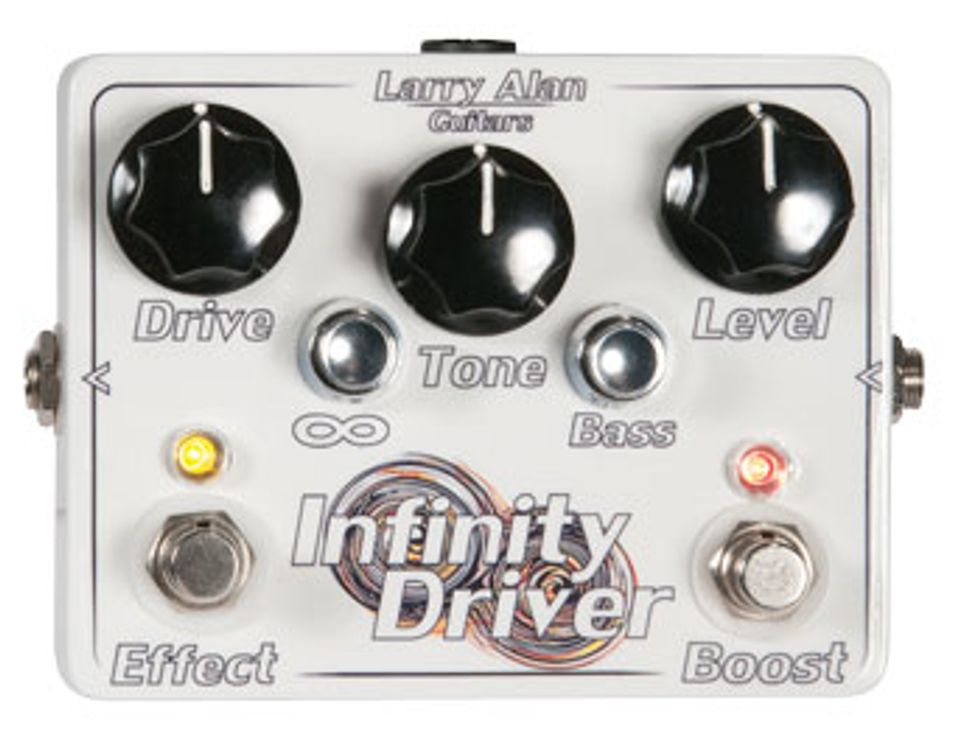
If you’re a pedal manufacturer in these glory days of stompbox design, it’s not easy to find a unique sonic signature. But Larry Alan (of Lansing, Michigan’s Larry Alan Guitars) seems perfectly willing to put the power to shape unique sounds into the hands of the player.
The Infinity Driver overdrive emphasizes versatility and the ability to play nice with myriad amps and guitars. In part, this flexibility is derived from the pedal’s simple, smart layout and the inclusion of a boost circuit. But the box also benefits from a germanium diode in the clipping stage that adds a whole range of color to the pedal’s sound palate, and with a bass switch in the mix to help even out the midrange emphasis that’s inherent to overdrive use, the Infinity Driver shapes up as an overdrive of, well, almost infinite potential.
Maximizing Real Estate
Built in a Hammond 1590BB-sized enclosure,
the Infinity Driver takes up a little more
room than say, a Boss or MXR pedal. But
you get a lot of switching potential for the
real estate. There are three big, black knobs
for drive, tone, and level, a switch for the germanium
diode (the Infinity function), a bass
switch that enhances low-end response, and
two stomp switches with dedicated LEDs for
the overdrive and boost functions.
Subtle Shades of Dirty
I checked out the Infinity through a Fender
Concert 2x10 with Eminence speakers—a
nice blank slate for discerning the nuances of
an overdrive—and played a G&L Comanche
and Epiphone Sheraton with Tom Holmes
PAFs. With the Fender set up clean and full,
and the G&L at the other end of the cable, I
set the Infinity’s drive, tone, and level knobs
to around noon. The volume was slightly
lower than the bypassed signal, so I pushed
up the level to around 2 o’clock. At these
settings, the Infinity gets louder and thicker.
I found that by rolling off the Comanche’s
volume knob a touch, I could get a relatively
clean and complex tone with a little extra
sweetly sustained thickness.
A nice feature of the Infinity’s higher-gain voice is that it’s virtually free of the grainy harshness that can plague high-gain pedals at lower levels—that alone is a significant difference between the Infinity Driver and lesser devices, and a factor worth considering if this pedal ends up on your short list of ODs. Even cranking the drive won’t add heaps of burning gain, but it does thicken up the tone further still, giving the G&L’s single-coils an almost humbucker-like weight.
Engaging the bass switch adds what seems like a bump in volume and gain in addition to a thickness that’s downright addictive. You also get more sustain and a pick responsiveness that just plain feels good—a far cry from the muddiness you might otherwise expect from a bass boost. Once I tried this function, it was hard not to use it, so I spent nearly my entire review time with the bass switch engaged.
The tone control is wonderfully effective. Many tone controls add little more than harshness or spiky treble past the noon mark, but that’s not at all the case with the Infinity. At the lowest settings the tone is darker, but without any real loss of definition. Crank it up and the tone remains focused and defined, but also surprisingly sweet.
Ratings
Pros:
wide range of overdrive tones.
Cons:
may not be enough gain for some players.
Tones:
Ease of Use:
Build:
Value:
Street:
$200
Larry Alan
larryalanguitars.com
With the Epiphone driving the output, the boost function added a high-mid edge that emphasized top-end zing. You may have to cut the tone control a bit to keep the sound from getting overly bright, though rolling back your guitar’s tone enables you to move between a nice, slicing lead sound and a tighter rhythm sound with ease.
The germanium diode, which is activated with the Infinity switch, completely transforms the Infinity Driver’s tonal character. The pedal gets grainier and more compressed, and you lose a little volume compared to the bypassed setting. The volume drop probably isn’t significant, given that few players will toggle between voices on the fly, and how the Infinity switch provides versatility that’s almost like adding a second, dirtier overdrive to your board.
The Verdict
Players who like their overdrive to work
like a jackhammer might find the Infinity
Driver a little subtle—at first. But you’ll
be sonically rewarded if you spend a little
time exploring the breadth of the Infinity
Driver’s capabilities and subtler aspects.
Even if you’re looking for a little aggression
from your OD, the Infinity Driver
can do the job. Just max the level and
you’ll achieve the near infinite sustain you
might get from a good compressor, along
with the tonal colors that come from driving
a tube amp hard. The boost function
made the guitars a bit bright, but also
added a welcome range and a cool voice
with a little more attitude.
Larry Alan has pulled off the considerable feat of bringing something new to the overdrive table. And if you’re looking for something a little more nuanced than the classics, it’s worth a real look and listen. To be certain, I haven’t played anything quite like it.






![Rig Rundown: Russian Circles’ Mike Sullivan [2025]](https://www.premierguitar.com/media-library/youtube.jpg?id=62303631&width=1245&height=700&quality=70&coordinates=0%2C0%2C0%2C0)

















